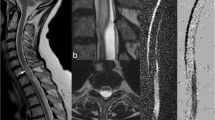Abstract.
Infarction is a rare cause of spinal cord dysfunction. Whereas diffusion-weighted (DW) MRI has been established as a highly sensitive technique for assessing acute cerebral ischemia, its role in spinal cord infarction remains to be determined. The purpose of this study is to present the signal characteristics of acute spinal cord ischemia using DWMRI within the first two days and after one week. MRI including DW imaging (DWI) was performed in three patients with acute spinal cord dysfunction 8, 12 and 30 hours after the onset of symptoms and repeated after one week in two patients. Two initial scans included EPI DW sequences in transverse and sagittal orientation. The remaining examinations were performed with an optimised highspatial resolution DWI sequence in the transverse plane. The diagnosis of spinal cord ischemia was established by imaging, clinical history and CSF analysis. T2 signal abnormality and restricted diffusion was demonstrated in all initial examinations. Transverse DW sequences had the highest sensitivity. The spinal infarctions were mainly located in the centre of the spinal cord and the grey matter. Contrast enhancement was absent. After one week, the restricted diffusion had normalised (pseudo normalisation) whereas the T2 signal changes had become more prominent. Restricted diffusion in the course of spinal cord ischemic infarction can be demonstrated using DW-MRI. Whereas a diffusion abnormality can be found after few hours, it does not last for longer than one week. At this time, the establishment of the diagnosis has to rely mainly on T2-weighted images with additional post contrast T1-weighted images being useful.
Similar content being viewed by others
References
Bammer R, Fazekas F, Augustin M, et al. (2000) Diffusion-weighted MR imaging of the spinal cord. AJNR Am J Neuroradiol 21(3):587–591
Gass A, Back T, Behrens S,Maras A (2000) MRI in spinal cord infarction. Neurology 54:2195
Kuker W, Thiex R, Friese S, et al. (2000) Spinal subdural and epidural haematomas: diagnostic and therapeutic aspects in acute and subacute cases. Acta Neurochir (Wien) 142(7):777–785
Kuker W, Weise J, Krapf H, Schmidt F, Friese S, Bahr M (2002) MRI characteristics of acute and subacute brainstem and thalamic infarctions: value of T2- and diffusion-weighted sequences. J Neurol 249(1):33–42
Mader I, Schoning M, Klose U, Kuker W (2002) Neonatal cerebral infarction diagnosed by diffusion-weighted MRI: pseudonormalization occurs early. Stroke 33(4):1142–1145
Oppenheimer DR (1978) The cervical cord in multiple sclerosis. Neuropathol Appl Neurobiol 4(2):151–162
Reich P, Muller-Schunk S, Liebetrau M, Scheuerer W, Bruckmann H,Hamann GF (2003) Combined cerebellar and bilateral cervical posterior spinal artery stroke demonstrated on MRI. Cerebrovasc Dis 15(1–2):143–147
Stepper F, Lovblad KO (2001) Anterior spinal artery stroke demonstrated by echo-planar DWI. Eur Radiol 11(12):2607–2610
Tartaglino LM, Friedman DP, Flanders AE, Lublin FD, Knobler RL, Liem M (1995) Multiple sclerosis in the spinal cord: MR appearance and correlation with clinical parameters. Radiology 195(3):725–732
Thron A (1988) Vascular anatomy of the spinal cord. Berlin, Heidelberg, New York: Springer
Warach S, Gaa J, Siewert B,Wielopolski P, Edelman RR (1995) Acute human stroke studied by whole brain echo planar diffusion-weighted magnetic resonance imaging. Ann Neurol 37: 231–241
Weidauer S, Dettmann E, Krakow K, Lanfermann H (2002) Diffusionsgewichtete MRT bei spinalen Infarkten: Darstellung von zwei Fällen und Literaturübersicht. Nervenarzt 73(10):999–1003
Weidauer S, Nichtweiss M, Lanfermann H, Zanella FE (2002) Spinal cord infarction: MR imaging and clinical features in 16 cases. Neuroradiology 44(10):851–857
Wiendl H, Strayle-Batra M, Schulz JB (2002) Very bright dorsal columns: spinal magnetic resonance imaging in funicular myelosis. Arch Neurol 59(1):147–148
Yuh WT, Marsh EE 3rd, Wang AK, et al. (1992) MR imaging of spinal cord and vertebral body infarction. AJNR Am J Neuroradiol 13(1):145–154
Author information
Authors and Affiliations
Corresponding author
Rights and permissions
About this article
Cite this article
Küker, W., Weller, M., Klose, U. et al. Diffusion-weighted MRI of spinal cord infarction. J Neurol 251, 818–824 (2004). https://doi.org/10.1007/s00415-004-0434-z
Received:
Revised:
Accepted:
Issue Date:
DOI: https://doi.org/10.1007/s00415-004-0434-z




